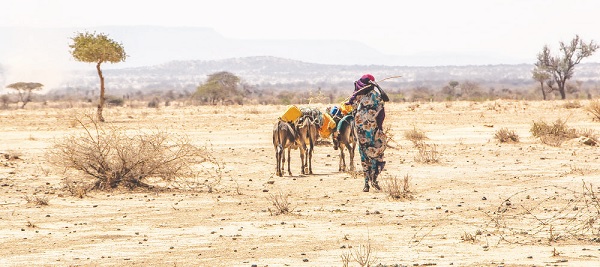
The IGAD Climate Prediction and Applications Centre (ICPAC) issued the June to September 2024 seasonal forecast indicating an increased likelihood of above-normal rainfall over most parts of the Greater Horn of Africa (GHA). The areas expected to experience these above-normal conditions include Djibouti, Eritrea, central and northern Ethiopia, western and coastal Kenya, much of Uganda, South Sudan, and Sudan.
The report indicated on the other hand that parts of northern Somalia, isolated areas over western Ethiopia, and north-western South Sudan are expected to experience drier-than-normal conditions. The climate patterns in the JJAS 2024 period closely resemble those of 1998 and 2010, both of which experienced wetter-than-normal conditions over much of the region.
An early to normal onset is expected in several parts of the region including central and northern Ethiopia, Eritrea, Sudan, and South Sudan. However, a delayed onset is likely in Djibouti, parts of eastern and western Ethiopia, central and western Sudan, and southern South Sudan.
The temperature forecast shows a probability of warmer-than-normal conditions across the region, particularly over northern Sudan, central and western Ethiopia, Somalia, Kenya, Rwanda, Burundi, and Tanzania.
Dr. Guleid Artan, ICPAC’s Director noted that “The Greater Horn of Africa (GHA) stands as a region that is highly susceptible to the adverse impacts of climate change, which pose significant challenges to the resilience of our communities. The forecasted wetter-than-normal conditions for June to September 2024 echo the patterns of 1998 and 2010, highlighting the level of impact especially for South Sudan and Sudan, which may experience impacts of floods.”
“As we observe these recurring extreme climate events, it is important to acknowledge the pivotal role played by early warning systems which serve as key instruments of preparedness, guiding us through climate variability. Through our operations, ICPAC continues to provide actionable climate information that is relevant and key for Early Action,” he added.
In line with the World Meteorological Organization’s guidelines and recommendations, ICPAC has adopted an objective seasonal forecast method to generate climate forecasts for the Greater Horn of Africa. May 2024 initialized seasonal forecasts from 9 Global Producing Centers (GPCs) were utilized and processed to develop the June – September 2024 seasonal climate outlook. The seasonal forecasts and their hind cast data were analyzed to provide a probabilistic forecast indicating the likelihood of above-normal, normal, or below-normal rainfall.
Extreme events are occurrences of unusually severe weather or climate conditions that can cause devastating impacts on communities and agricultural and natural ecosystems. Weather-related extreme events are often short-lived and include heat waves, freezes, heavy downpours, tornadoes, tropical cyclones and floods. Climate-related extreme events either persist longer than weather events or emerge from the accumulation of weather or climate events that persist over a longer period of time. Examples include drought resulting from long periods of below-normal precipitation or wildfire outbreaks when a prolonged dry, warm period follows an abnormally wet and productive growing season.
Given all these changing trends in climatic conditions in East Africa, and the decades-old vulnerability of the region, IGADs Climate Modeling Expert (Climate Scientist) Hussein Seid (PhD) says governments and the concerned institutions must take proactive action to address the impact of climate change. So as I mentioned earlier we need to move like from this reactive approach which is responding and reacting quickly to the situation to more of this proactive approach which is preparing and planning for future circumstances.
According to ICPACs report as well as Hussein’s earlier explanation the current situation is going to also increase these climate Extremes in the future in our region.
“We should invest in climate-resilient infrastructures. This could be like flood protection measures it could be resilient agricultural practices, and also the irrigation systems or strengthening dams. This kind of I think Investments are very key to reducing the impact of climate extremes. Also, we need to implement adaptation strategies tailored to local contexts if there are areas affected by droughts then we need to promote these drought-resistant crops”
The expert further reiterates that as part of the precautionary activities concerned bodies need to implement sustainable land management practices and diversifying the livelihoods of the people to reduce dependence on the climate sector. He explains that there are several ways and also one of the adaptation tools is the early warning system or government really should invest in the development of a robust early warning system that provides timely and accurate information to the vulnerable population.
These climate extremes are increasing from time to time and we are likely also to experience more extremes in the future under a changing climate. So we need to prepare for that one. We need to use the available information, to prepare and also, reduce the impact of this climate extreme that we are currently seeing. It is important to invest in the climate smart infrastructures.
“All the things that we are doing currently should be climate Smart in the agriculture sector in the infrastructure or even the other sectors, need to be climate smart. So that is what I’m saying. We need to use the available information. Now the national methodological agencies are issuing forecasts and warning information”
According to Hussein in addition to issuing the necessary cautionary information and warning system, it is important to take practical actions that go along with the early warning system. “The Regional Climate Center, ICPAC is producing this information. So the information is there but the action is not really to that level. So for example for this season, we have issued a forecast in February that we are going to experience and enhance the rainfall over our region. So we issued we have shared this information with our stakeholders but the actions that are taken are not really that satisfactory”
BY ZEKARIAS WOLDEMARIAM
THE ETHIOPIAN HERALD WEDNESDAY 29 MAY 2024





